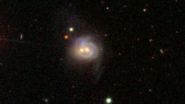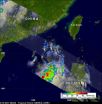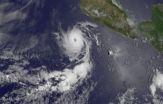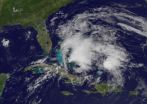(Press-News.org) This release is available in Spanish.
A U.S. Department of Agriculture (USDA)-led consortium of scientists has fully sequenced the genome of the pathogen that causes the wheat disease known as septoria tritici blotch, which can cause significant yield losses.
According to the International Maize and Wheat Improvement Center in Mexico, losses can reach as high as 50 percent if fungicides are not used to protect susceptible wheat lines. Thise disease is found in every wheat-growing area in the world, including the United States. The research, published in PLoS Genetics, may lead to strategies to control this disease.
The USDA scientists work for the Agricultural Research Service (ARS), USDA's chief intramural scientific research agency.
The pathogen that causes the disease, Mycosphaerella graminicola, has a long "silent period," a latent stage during which it takes nutrition from the living plant and evades the host plant's natural defenses. Scientists previously did not have a good understanding of how the organism infects wheat, or how the wheat plant itself resists the pathogen. Sequencing the genome of the pathogen could help answer these questions, among others.
"Having a complete sequence of the M. graminicola genome will give researchers across the globe the tools necessary to mitigate the damage this pathogen causes to wheat crops," said ARS Administrator Edward B. Knipling.
M. graminicola employs "stealth" pathogenicity, the ability to infect the host plant without the plant mounting an adequate defense response, if any at all.
"A lot of pathogens infect host plants by penetrating the plant's cell wall," said plant pathologist Stephen Goodwin at the ARS Crop Production and Pest Control Research Unit in West Lafayette, Ind. "But this organism grows into the plant's natural openings, the stomata, which are normally used for gas exchange. The pathogen then grows in between the cell walls without triggering defense responses that are designed to stop infection."
The pathogen goes into its "silent period" and then switches to a pathogenic (disease-causing) stage. "We don't know what happens in that switch from the latent phase to the pathogenic phase," Goodwin said. "The gene sequence will allow scientists to look at the expression of all of those genes involved in the transition period."
###
Goodwin led the sequencing effort and is a lead author of the paper, along with Igor V. Grigoriev of the U.S. Department of Energy's Joint Genome Institute in Walnut Creek, Calif., and Gert H. J. Kema of the Plant Research International B.V., Wageningen, The Netherlands. The international research team also included scientists in Australia, Brazil, France, Germany, Iran, Mexico, Switzerland, and The United Kingdom.
USDA is an equal opportunity provider, employer and lender. To file a complaint of discrimination, write: USDA, Director, Office of Civil Rights, 1400 Independence Ave., S.W., Washington, D.C. 20250-9410 or call (800) 795-3272 (voice), or (202) 720-6382 (TDD).
USDA-led consortium sequences genome of key wheat pathogen
2011-06-11
ELSE PRESS RELEASES FROM THIS DATE:
New substances added to HHS Report on Carcinogens
2011-06-11
The U.S. Department of Health and Human Services today added eight substances to its Report on Carcinogens, a science-based document that identifies chemicals and biological agents that may put people at increased risk for cancer.
The industrial chemical formaldehyde and a botanical known as aristolochic acids are listed as known human carcinogens. Six other substances – captafol, cobalt-tungsten carbide (in powder or hard metal form), certain inhalable glass wool fibers, o-nitrotoluene, riddelliine, and styrene – are added as substances that are reasonably anticipated ...
Nearby galaxy boasts 2 monster black holes, both active
2011-06-11
GREENBELT, Md. -- A study using NASA's Swift satellite and the Chandra X-ray Observatory has found a second supersized black hole at the heart of an unusual nearby galaxy already known to be sporting one.
The galaxy, which is known as Markarian 739 or NGC 3758, lies 425 million light-years away toward the constellation Leo. Only about 11,000 light-years separate the two cores, each of which contains a black hole gorging on infalling gas.
The study will appear in a forthcoming issue of The Astrophysical Journal Letters.
"At the hearts of most large galaxies, including ...
Domestic Violence: Convictions Can Change Everything
2011-06-11
Domestic violence can destroy a family. Not only does the physical abuse result in pain and suffering for the victim, but the long-term mental anguish also can make it difficult for everyone involved in the situation. Even false allegations of domestic violence can create problems that can forever change a person's life. Because of the emotionally-charged nature of these crimes, many people simply plead guilty to try to make the matter disappear, often without realizing the implications of their actions.
The number of reported domestic violence cases remains high. According ...
Pennsylvania Superior Court Upholds $3 Million Verdict
2011-06-11
The Pennsylvania Superior Court recently upheld the verdict for the estate of a woman who was 87 years old at the time of her death was awarded $3 million in a wrongful death action in Philadelphia.
A Vibrant 87-year-old
Jeanette Kessler went in for elective knee surgery. She was described by her lawyer, Ed Chacker, as a vibrant 87-year-old.
She spent time with friends, took trips to Atlantic City, played cards and was the designated driver for dinner trips with friends.
She took exercise classes weekly and participated in line dancing, he said.
Chacker commented ...
Can small loans reduce poverty?
2011-06-11
Small loans, somewhere in the neighborhood of $100 to $500 dollars, are an increasingly popular weapon in the fight to reduce poverty. Called microcredit, institutions dole out these monetary advances to help extremely poor people engage in successful entrepreneurship and improve their quality of life.
While proponents extol its virtues, researchers look for evidence; they want to know if it works. Does it really increase financial development and help individuals make solid monetary decisions as its supporters claim?
"Microfinance works," said Dean Karlan, economics ...
NASA sees heavy rainfall in Tropical Storm Sarika
2011-06-11
Tropical Depression 05W has grown into a tropical storm and given the name Sarika as it heads toward China. Satellite imagery from NASA shows that the center of the storm seems to be separated from the strongest thunderstorms.
The Tropical Rainfall Measuring Mission (TRMM) satellite that is co-managed by NASA and the Japanese Space Agency measures rainfall in the tropics, and today's satellite imagery (June 10, 2011) on Tropical Storm Sarika shows that the heaviest rainfall (falling at 2 inches/50 mm per hour) is south of the center of the storm's circulation. That's ...
Who's My Lawyer?
2011-06-11
If you are calling your immigration attorney's office and find yourself asking this question, your case may be in serious trouble. Recently, I have been contacted by scores of individuals seeking consultation on their cases because they cannot ascertain who is supposed to be taking care of their cases at the law firm they retained! Although this sounds absurd, the problem is that the "big" firms they hired have a serious problem with employee turnover: attorneys quitting their jobs and leaving their cases behind.
People seeking an attorney are always in a vulnerable ...
Eye say, Adrian is still a powerful hurricane on NASA satellite imagery
2011-06-11
Hurricane Adrian has been good at hiding his eye from satellite imagery over the last two days, but the latest Aqua and GOES-13 satellite imagery provides the best look at the eye, despite some overcast inside.
The Geostationary Operational Environmental Satellite called GOES-11 captured a visible image of Major Hurricane Adrian on June 10 at 1601 UTC (12:01 p.m. EDT).The image, that shows the eye of the storm with some dense overcast in it, was made at the NASA GOES Project out of NASA Goddard Space Flight Center, Greenbelt, Md. GOES-13 is managed by NOAA.
When NASA's ...
Aer Lingus Celebrates 75th Anniversary
2011-06-11
Aer Lingus has unveiled a new retro painted aircraft in the former 1960s 'Irish International' livery, to mark its 75th anniversary celebrations. The newest addition to the fleet, an Airbus A320- EI-DVM, MSN 4634 series, named 'St Coleman', was painted especially for the anniversary celebrations and unveiled at a ceremony at the iconic, Old Central Terminal Building Dublin airport - designed by the late Desmond FitzGerald.
Cabin crew modelled vintage uniforms, from each decade beginning 1945 through to the current Aer Lingus uniform by acclaimed designer, Louise Kennedy.
Speaking ...
NASA sees the low that won't quit: System 94L
2011-06-11
The northern Caribbean low pressure area known as System 94L is continually monitored by the GOES-13 Satellite, imagery today shows that it has moved north and is raining on eastern Cuba and the Bahamas.
The National Hurricane Center has resumed noting that this system has a meager chance of developing into a tropical depression. In an update today from NHC, they note that System 94L has a 10 percent chance of developing in the next 48 hours. The chances of development are still low because upper-level winds are strong enough to prevent any organization of the low.
Meanwhile, ...




